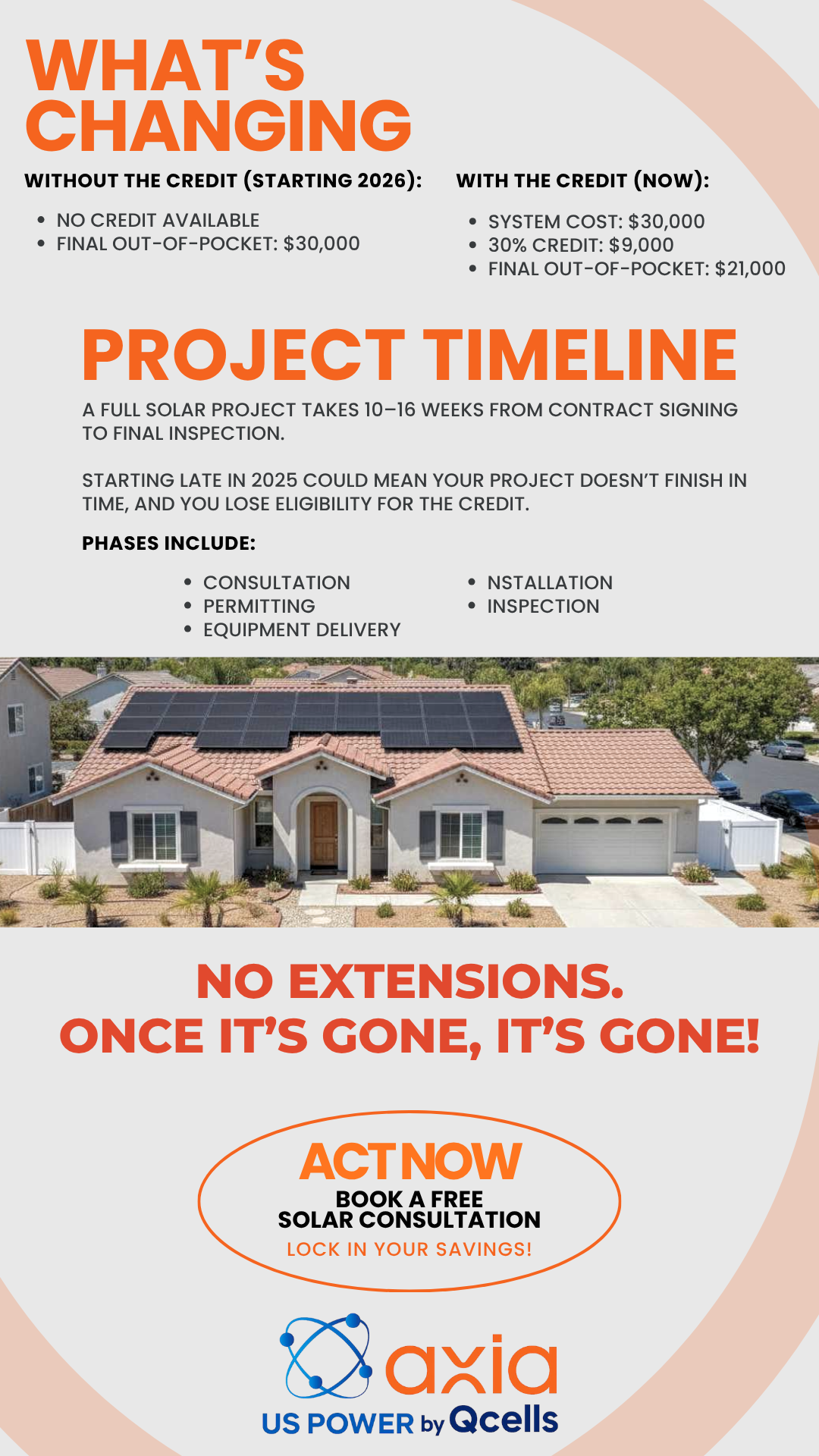30% Solar Tax Credit Ends in 60 days and Not Coming Back!

Solar and Roofing Advisor
Claim your 30% solar tax credit before time runs out, Dec 31, 2025. Beat high utility rates in Southern California with QCells solar panels through US Power.

The clock is officially ticking for homeowners considering solar. The Federal Residential Clean Energy Credit, widely known as the 30% Federal Solar Tax Credit, will end on December 31, 2025, marking the final opportunity for California residents to secure one of the nation’s most valuable clean-energy incentives.
With record-high electricity costs across Los Angeles, Ventura, Orange, and San Diego Counties, the repeal of this federal benefit is expected to have a major impact on household energy economics in the coming year.
What the 30% Federal Solar Tax Credit Covers
The Residential Clean Energy Credit (IRC §25D) has been the backbone of residential solar adoption since 2005. It allows homeowners to deduct 30% of the total system cost from their federal tax bill — including panels, inverters, racking, electrical upgrades, and installation labor. The credit even extends to solar batteries installed with or after a solar system.
For instance, a $30,000 solar project could yield a $9,000 direct tax reduction. Unlike a deduction that lowers taxable income, this credit offsets the actual taxes owed.
The incentive has no cap and can roll forward to future tax years if not fully used. Over the past two decades, it has driven solar growth nationwide — with California leading all states, representing nearly half of all U.S. residential solar installations.
However, under newly passed federal legislation, this benefit will terminate for residential systems placed in service after December 31, 2025 — ending earlier than previously planned under the Inflation Reduction Act.
Why the Credit Is Ending
The repeal is part of a larger federal spending reform passed in late 2025, targeting clean-energy subsidies as part of the government’s budget balancing efforts. While the Inflation Reduction Act initially extended the solar credit through 2032, new legislation overrides that timeline, making 2025 the final year for homeowners to claim the full 30% benefit.
Once the deadline passes, the incentive will not phase down — it will end entirely for homeowner-owned solar installations.

Industry analysts predict a surge in installations across the country through 2025 as homeowners rush to secure their systems before the credit expires.
Southern California’s High Utility Rates Fuel Urgency
Southern California homeowners face some of the highest power costs in the nation — and they’re still climbing.
As of mid-2025, the average residential electricity rate in Southern California Edison (SCE) territory stands at approximately 31.4¢ per kilowatt-hour (kWh), while Los Angeles Department of Water and Power (LADWP) and San Diego Gas & Electric (SDG&E) customers pay roughly 33¢–34¢/kWh.
These prices are more than double the U.S. average and are expected to rise again in early 2026 due to wildfire-mitigation, transmission upgrades, and renewable-grid reliability projects mandated by the California Public Utilities Commission (CPUC).
For context, a typical Southern California home using 750 kWh per month pays about $230–$250 in monthly electricity costs, up from roughly $160 just five years ago.
This makes solar one of the most powerful defenses against long-term rate hikes — but only if installed while incentives still exist.
What Happens After December 31, 2025
Once the credit expires:
- Homeowners will lose the 30% federal incentive, increasing the effective out-of-pocket cost by thousands.
- The average 7-kW residential system, currently costing around $2.60–$3.25 per watt (before incentives), will jump in cost by roughly $8,000–$10,000 overnight.
- Payback periods will stretch from the current 5–7 years to approximately 8–10 years.
- Battery systems — which also qualify for the same 30% credit — will lose eligibility unless installed and commissioned before the cutoff date.
For homeowners under California’s NEM 3.0 policy, solar batteries are already essential to optimize savings under new time-of-use billing. Losing both the solar and battery tax credits could make waiting far more expensive than acting now.
The Importance of Acting Early
Meeting the December 31, 2025 deadline requires foresight. Solar installations take time — usually 10–16 weeks from site assessment to permission to operate.
Here’s what’s included in that timeline:
- System design and engineering approvals
- City or county permit processing (which can take several weeks depending on jurisdiction)
- Utility interconnection review
- Installation and final inspection
With the expected end-of-year rush, homeowners are advised to start the process no later than May 2025 to ensure installation and activation before the deadline.
Municipalities such as Los Angeles, Santa Clarita, and Thousand Oaks have already experienced permitting delays due to increased solar demand.
How California’s Local Incentives Can Still Help
Even as the federal credit ends, California’s state-level programs continue to provide valuable support. The Self-Generation Incentive Program (SGIP) offers rebates for battery storage systems, providing up to $1,000 per kilowatt-hour (kWh) of installed capacity for qualifying homes — particularly those in fire-prone or low-income areas.
These local incentives can reduce solar battery costs by 40–50% when combined with the federal tax credit — a key reason experts recommend pairing solar with storage before 2026.
Additionally, property owners in Los Angeles and Ventura Counties may still benefit from Property Assessed Clean Energy (PACE) financing, which allows system costs to be repaid through property taxes over time, improving affordability even after the credit ends.
Southern California’s Solar Advantage
Despite the policy change, Southern California remains one of the most solar-friendly regions in the world. With an average of 284 sunny days per year, homeowners enjoy consistent solar production that offsets most household consumption.
Technological improvements have also boosted efficiency and aesthetics. Panels like the QCells Q.PEAK DUO BLK ML-G10+ and Maxeon 425 Black Series deliver over 21% module efficiency and maintain performance for 25–40 years — far exceeding the lifespan of traditional energy investments.
These systems generate more energy in less space and are paired with advanced monitoring tools that track savings in real time.
How Homeowners Can Prepare Before the Deadline
To ensure eligibility and maximize value, homeowners should:
- Schedule a professional site assessment now. A local expert can evaluate your roof structure, electrical capacity, and shading conditions.
- Choose Tier 1 panels. American-made options like QCells offer long-term warranties and high efficiency.
- Include battery storage. It future-proofs your system and qualifies for the same 30% credit (until 2025).
- Act months ahead. Permitting and interconnection backlogs will grow as the deadline approaches.
- Consult a tax professional. Proper documentation ensures smooth credit claims on your 2025 return.
Local Spotlight: US Power Leading the Transition
US Power, a trusted solar installer across Southern California, is helping homeowners secure their systems before the 2025 cutoff.
With an exclusive partnership with QCells, US Power delivers factory-direct pricing on American-made solar panels, providing premium quality at a lower cost. The company’s in-house team handles design, permitting, installation, and interconnection — streamlining the process so projects are completed on time.
US Power also specializes in solar-plus-storage systems, optimizing savings under California’s new NEM 3.0 structure and helping homeowners reduce dependence on the grid.
For homeowners planning to go solar, now is the best and possibly the last chance to lock in all available incentives.
Secure Your 30% Savings Before It’s Gone
The 30% Federal Solar Tax Credit officially ends December 31, 2025, and once it’s gone, it’s gone for good. With utility rates rising and installation queues growing, waiting until late next year could mean missing out entirely.
Southern California homeowners have the sunlight, incentives, and technology to take full control of their energy future — but time is running out.
The end of the Federal Solar Tax Credit marks a turning point for California’s clean-energy movement. For Southern California homeowners, 2025 is the final opportunity to combine federal and state incentives, offset record-high utility costs, and secure long-term energy independence.
Act now to save thousands before the incentive disappears.
Schedule a FREE solar consultation and learn how to lock in your 30% federal savings before the deadline.
With US Power’s exclusive QCells partnership and turnkey installation services, going solar now isn’t just smart — it’s essential.
Frequently Asked Questions
Related Articles
Our Related Blogs
Cut PG&E bills with solar and battery power this winter with zero grid savings.
Learn why Solar-only loses value under PG&E’s new rules—battery pairing is key.
Your complete 2025 US Power guide to 2kW solar systems in Southern California.
Our Solar and Roof Brand Partners








We empower communities and businesses to harness clean, renewable solar energy solutions that drive sustainable growth.
Ready to Own Your Power? Call us today!
818-650-8010
Copyright © 2025 US Power - Axia by QCells. All Rights Reserved.
Privacy is important to us, so you have the option of disabling certain types of storage that may not be necessary for the basic functioning of the website. Blocking categories may impact your experience on the website.
Essential
These items are required to enable basic website functionality.
Personalization
These items allow the website to remember choices you make (such as your user name, language, or the region you are in) and provide enhanced, more personal features.
Marketing
These items are used to deliver advertising that is more relevant to you and your interests.
Analytics
These items help the website operator understand how its website performs, how visitors interact with the site, and whether there may be technical issues.
We and our third-party partners use cookies and other technologies to enhance and track your experience on this site, conduct analytics, and personalize marketing to you. By using the site, you agree to our use of these technologies, including recording and monitoring your interactions with the site.
Get an instant solar estimate using satellite!









